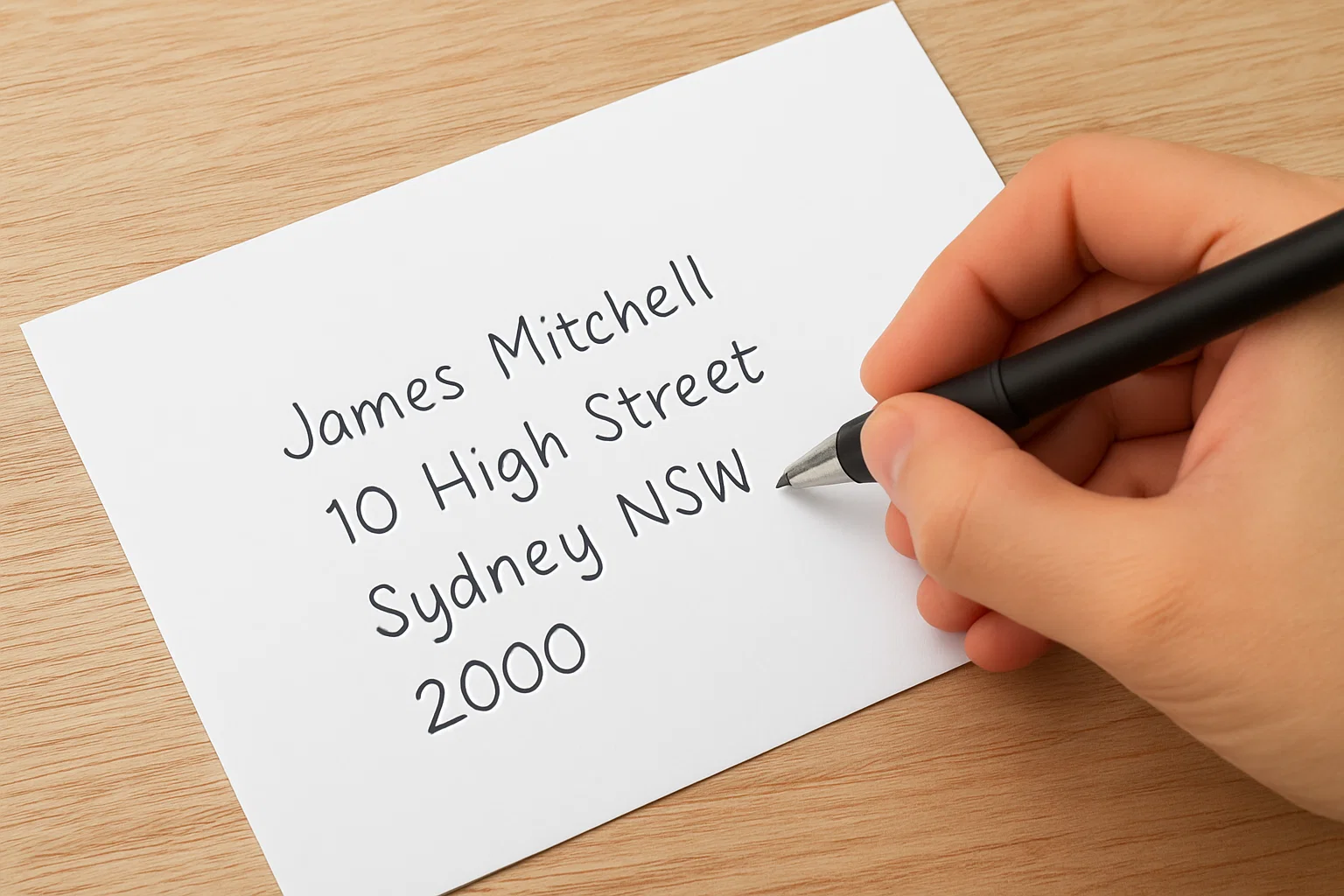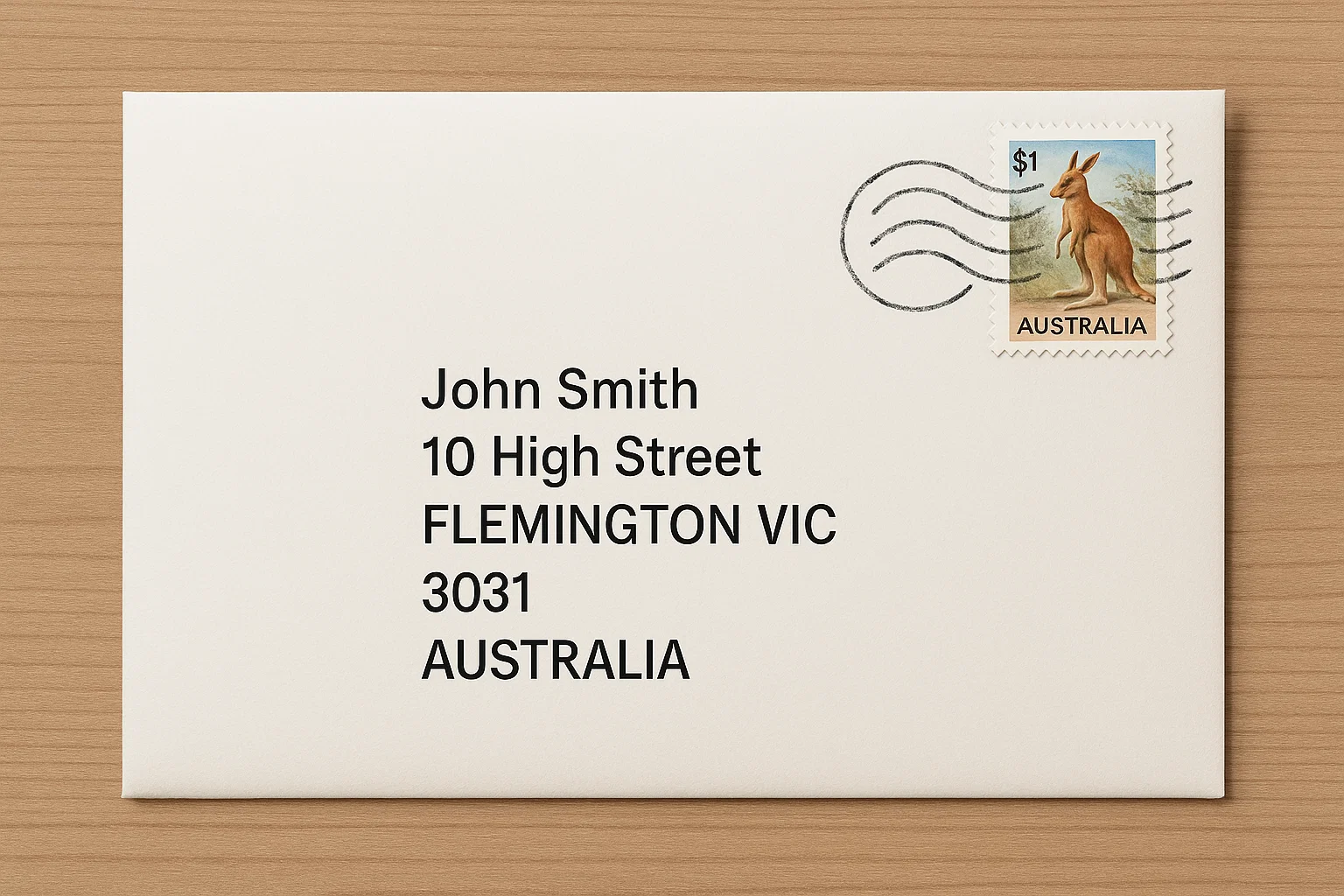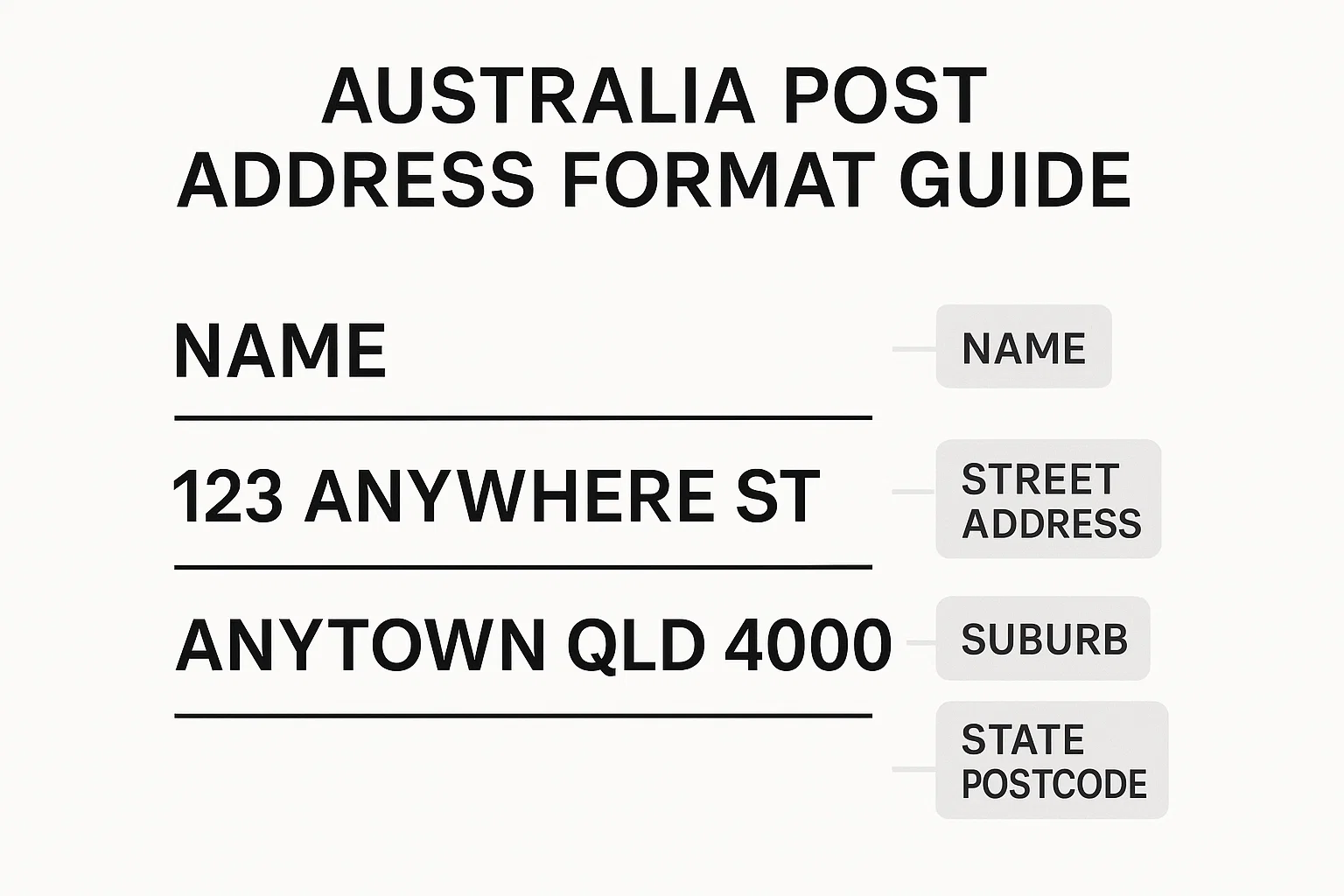Don’t worry, you’re not the only one. Even locals mix it up sometimes.
Getting an Australian address right isn’t just about neat handwriting it’s about understanding a simple but specific structure that helps mail reach the right place, fast. Australia Post (the country’s national postal service) uses a standard format for everything, from local postcards to international deliveries. And once you get the hang of it, it’s actually super logical.
Let’s break it down step by step no jargon, no confusion, just real-world examples you can use right now.
Why Getting the Address Format Right Matters
Australia’s a big place like, really big. From Perth to Sydney, there are thousands of suburbs that share similar street names.
A tiny mistake say, writing “Melbourne” instead of “Melbourne VIC 3000” could send your letter wandering across the country before it ever reaches its destination.
When your address format is spot on:
- Your mail reaches faster.
- The delivery team can scan and sort it automatically.
- It avoids the dreaded “return to sender” stamp.
In short, the right format = fewer delays, less stress, and no awkward “did you get my letter?” messages.
Understanding the Structure of an Australian Address
An Australian address usually follows this simple four-line structure:
- Recipient’s Name
- Street Address (or PO Box)
- Suburb / Locality + State + Postcode
- (Optional) AUSTRALIA only for international mail
Here’s what that looks like in real life:
Let’s unpack it.
- Line 1: Recipient’s Name Write the person or company’s full name. Titles like Mr, Ms, or Dr are optional.
- Line 2: Street Address Include the building number and street name. Apartment or unit numbers go before the street number (e.g. Unit 4 / 12 River Road).
- Line 3: Suburb, State, Postcode This line is the key. The suburb (like North Sydney) is followed by a space, then the state abbreviation, then the four-digit postcode.
- Line 4: Country Name Only add “AUSTRALIA” if you’re sending from overseas.
Easy, right? But let’s see a few examples to make it even clearer.
Standard Australian Address Format Example
Here are a few everyday address examples used in Australia:
🏠 Residential Address
This one shows a typical apartment address. Notice how the unit number comes before the street number.
🏢 Business Address
For offices or companies, include the floor or suite before the building number.
📮 PO Box Address
PO Boxes are common for businesses and rural homes. Just replace the street line with “PO Box + number”.
Each of these examples follows the same rhythm name, address, suburb + state + postcode. That’s the magic formula.
How To Write an Australian Address for International Mail
Sending something to Australia from the USA, UK, or elsewhere? The rules stay mostly the same you just need to add AUSTRALIA at the end in capital letters.
For example:
If you’re mailing from the USA, you’ll also need to include your own country’s postage and sometimes an international prefix like “AIR MAIL” on the top left of the envelope.
But the recipient’s part (the Australian address) should look exactly like the example above.
Tip: Never write the country name anywhere else on the envelope only on the last line in ALL CAPS. That’s how international mail sorting systems recognise it.
How To Format an Address for Online Forms
If you’re buying something online, booking a hotel, or filling in delivery details, you might notice those neat little fields labelled “Address Line 1,” “Address Line 2,” etc.
Here’s how to use them correctly:
| Field | What to Enter | Example |
|---|---|---|
| Full Name | Your full name | Hannah Green |
| Address Line 1 | Street number and street name | Unit 3 / 14 Ocean Drive |
| Address Line 2 | Optional – apartment name or building | (leave blank or add floor name) |
| Suburb / City | The suburb (not the big city) | Bondi Beach |
| State | Use the two- or three-letter abbreviation | NSW |
| Postcode | Four-digit code | 2026 |
| Country | Australia | Australia |
And here’s the big one don’t confuse suburb with city.
In Australia, every suburb has its own postcode, even within a big city like Sydney or Melbourne. So “Bondi Beach” isn’t just part of Sydney it’s its own suburb with postcode 2026.
Australian State and Territory Abbreviations
This is where a lot of people trip up.
Australia has six states and two territories, each with an official two- or three-letter abbreviation used in every address.
| State/Territory | Abbreviation | Example Postcode |
|---|---|---|
| New South Wales | NSW | 2000–2999 |
| Victoria | VIC | 3000–3999 |
| Queensland | QLD | 4000–4999 |
| South Australia | SA | 5000–5999 |
| Western Australia | WA | 6000–6999 |
| Tasmania | TAS | 7000–7999 |
| Northern Territory | NT | 0800–0999 |
| Australian Capital Territory | ACT | 0200–0299 |
When writing or printing addresses, always use uppercase for state abbreviations no periods, no lowercase letters.
So it’s Sydney NSW 2000, not Sydney N.S.W. 2000.
Common Mistakes People Make (and How to Avoid Them)
Even with such a simple structure, people still mess it up. Let’s fix that before it happens to you.
❌ Using commas everywhere
While commas are common in US or UK address styles, Australia Post prefers a clean format without punctuation.
So instead of:
write:
❌ Forgetting the postcode
No postcode = chaos. Australia Post’s sorting system lives on those four digits.
Double-check before sending.
❌ Mixing up city and suburb
As mentioned, use the suburb name, not the city.
“North Sydney” is correct; “Sydney” alone might delay the letter.
❌ Lowercase state abbreviations
It’s VIC, not Vic or vic. Stick to uppercase for clarity.
❌ Adding country for local mail
Only write AUSTRALIA if you’re sending from another country. Domestic letters don’t need it.
A little attention to these details makes your mail look professional and saves time later.
Mailing a Letter to Australia from the USA
Okay, let’s say you’re in California and you’re mailing a birthday card to your Aussie cousin in Brisbane.
Here’s what the full envelope should look like:
Front of the envelope:
Top left corner (your return address):
Top right corner:
Place an international stamp (current rate via USPS).
Label:
Write AIR MAIL in small print above the destination address if required.
Mail usually takes 6–10 business days from the US to Australia, depending on the service level.
How Businesses Format Addresses Professionally
Businesses and organisations in Australia follow the same rules but with a few professional touches.
Here’s a typical example used in invoices, letterheads, or parcels:
Or for a warehouse or logistics company:
Some add an attention line when sending to a specific person:
The attention line helps large offices route the mail faster internally.
Bonus tip:
For printed materials like invoices, make sure the postcode aligns right on the last line that’s how Australia Post’s sorting machines read them most efficiently.
Quick Checklist Before Sending Your Mail
Before sealing that envelope or hitting “submit” on your form, run through this short checklist:
✅ Recipient’s full name is clear and correct
✅ Street number and name are accurate
✅ Unit/floor/level included (if any)
✅ Suburb name spelled correctly
✅ State abbreviation in uppercase
✅ Four-digit postcode added
✅ “AUSTRALIA” only for international mail
✅ Return address written neatly (optional but smart)
If you tick every box here, your letter’s ready to go.
Let’s Talk Postcodes the Secret Sorting Code
Australian postcodes aren’t random; they follow a regional logic.
Each range represents a particular state or area. For example:
- 2000 = Sydney CBD (NSW)
- 3000 = Melbourne CBD (VIC)
- 4000 = Brisbane (QLD)
- 5000 = Adelaide (SA)
- 6000 = Perth (WA)
Knowing the pattern helps you spot errors quickly. If someone writes “Melbourne NSW 3000,” you’ll instantly know something’s off that postcode belongs to Victoria, not New South Wales.
You can check exact postcodes on the Australia Post website, but most online forms autofill them once you type the suburb.
Writing Addresses for Rural or Regional Australia
City addresses are easy, but what about those wide-open outback towns?
Rural Australia uses a mix of street, property name, or mail service numbers. Here’s an example:
Some rural homes rely on Roadside Mail (RMB) or Community Mail Bags (CMB) Australia Post assigns numbers to these delivery points.
Example:
Don’t worry, even these unusual addresses follow the same final format: locality + state + postcode.
How to Include an Address in a Letter or Document
If you’re writing a formal letter (say, a job application or business correspondence), your address appears at the top just like in the UK format, but adapted to Australian style.
Example:
Professional, neat, and Australia Post approved.
A Quick Look at the Digital Side E-commerce, Forms, and Labels
Online delivery systems use databases tied to postcodes and suburbs, so when you start typing “Bondi…”, it automatically fills in Bondi Beach NSW 2026.
That’s not random it’s powered by Australia Post’s official addressing API, which ensures every package is linked to a valid delivery route.
When printing shipping labels, the rules stay the same:
- Keep it uppercase
- Don’t abbreviate street names (write Road, not Rd.)
- Avoid punctuation
- Use clear, readable fonts
Simple, bold, and clean design helps scanners pick up every line without human input.
A Few Real-Life Australian Address Examples
Let’s end with a few mixed samples you can model yours on:
Example 1 – Personal Letter (Local)
Example 2 – Package Delivery
Example 3 – Business Correspondence
Example 4 – Overseas Mail
These layouts might look minimal, but that’s the beauty of Australian formatting clean, logical, and easy to scan.
The Bottom Line
Writing an Australian address correctly isn’t complicated once you know the pattern.
It’s all about consistency name, address, suburb + state + postcode that’s it.
Follow this structure whether you’re mailing from Sydney or San Francisco, and your letter will glide through the postal system like a pro.
So next time you’re filling out a form or posting a package to Australia, take a deep breath, grab your pen, and line it up right. Your mail’s already halfway there.

Rachel combines her technical expertise with a flair for clear, accessible writing. A graduate of the University of Edinburgh, she specializes in creating detailed tech-focused content that educates our readers about the latest in web development and SEO tools at Spinbot blog.


